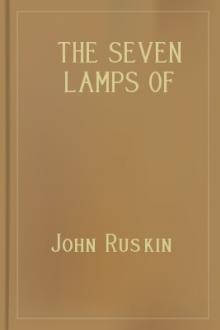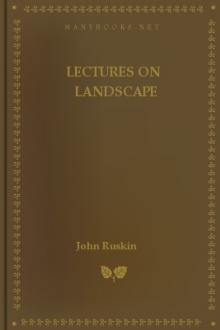The Seven Lamps of Architecture by John Ruskin (books like harry potter TXT) 📕

- Author: John Ruskin
- Performer: -
Book online «The Seven Lamps of Architecture by John Ruskin (books like harry potter TXT) 📕». Author John Ruskin
It would be well if moralists less frequently confused the greatness of a sin with its unpardonableness. The two characters are altogether distinct. The greatness of a fault depends partly on the nature of the person against whom it is committed, partly upon the extent of its consequences. Its pardonableness depends, humanly speaking, on the degree of temptation to it. One class of circumstances determines the weight of the attaching punishment; the other, the claim to remission of punishment: and since it is not easy for men to estimate the relative weight, nor possible for them to know the relative consequences, of crime, it is usually wise in them to quit the care of such nice measurements, and to look to the other and clearer condition of culpability; esteeming those faults worst which are committed under least temptation. I do not mean to diminish the blame of the injurious and malicious sin, of the selfish and deliberate falsity; yet it seems to me, that the shortest way to check the darker forms of deceit is to set watch more scrupulous against those which have mingled, unregarded and unchastised, with the current of our life. Do not let us lie at all. Do not think of one falsity as harmless, and another as slight, and another as unintended. Cast them all aside: they may be light and accidental; but they are an ugly soot from the smoke of the pit, for all that; and it is better that our hearts should be swept clean of them, without over care as to which is largest or blackest. Speaking truth is like writing fair, and comes only by practice; it is less a matter of will than of habit, and I doubt if any occasion can be trivial which permits the practice and formation of such a habit. To speak and act truth with constancy and precision is nearly as difficult, and perhaps as meritorious, as to speak it under intimidation or penalty; and it is a strange thought how many men there are, as I trust, who would hold to it at the cost of fortune or life, for one who would hold to it at the cost of a little daily trouble. And seeing that of all sin there is, perhaps, no one more flatly opposite to the Almighty, no one more "wanting the good of virtue and of being," than this of lying, it is surely a strange insolence to fall into the foulness of it on light or on no temptation, and surely becoming an honorable man to resolve that, whatever semblances or fallacies the necessary course of his life may compel him to bear or to believe, none shall disturb the serenity of his voluntary actions, nor diminish the reality of his chosen delights.
II. If this be just and wise for truth's sake, much more is it necessary for the sake of the delights over which she has influence. For, as I advocated the expression of the Spirit of Sacrifice in the acts and pleasures of men, not as if thereby those acts could further the cause of religion, but because most assuredly they might therein be infinitely ennobled themselves, so I would have the Spirit or Lamp of Truth clear in the hearts of our artists and handicraftsmen, not as if the truthful practice of handicrafts could far advance the cause of truth, but because I would fain see the handicrafts themselves urged by the spurs of chivalry: and it is, indeed, marvellous to see what power and universality there is in this single principle, and how in the consulting or forgetting of it lies half the dignity or decline of every art and act of man. I have before endeavored to show its range and power in painting; and I believe a volume, instead of a chapter, might be written on its authority over all that is great in architecture. But I must be content with the force of instances few and familiar, believing that the occasions of its manifestation may be more easily discovered by a desire to be true, than embraced by an analysis of truth.
Only it is very necessary in the outset to mark clearly wherein consists the essence of fallacy as distinguished from supposition.
III. For it might be at first thought that the whole kingdom of imagination was one of deception also. Not so: the action of the imagination is a voluntary summoning of the conceptions of things absent or impossible; and the pleasure and nobility of the imagination partly consist in its knowledge and contemplation of them as such, i.e. in the knowledge of their actual absence or impossibility at the moment of their apparent presence or reality. When the imagination deceives it becomes madness. It is a noble faculty so long as it confesses its own ideality; when it ceases to confess this, it is insanity. All the difference lies in the fact of the confession, in there being no deception. It is necessary to our rank as spiritual creatures, that we should be able to invent and to behold what is not; and to our rank as moral creatures that we should know and confess at the same time that it is not.
IV. Again, it might be thought, and has been thought, that the whole art of painting is nothing else than an endeavor to deceive. Not so: it is, on the contrary, a statement of certain facts, in the clearest possible way. For instance: I desire to give an account of a mountain or of a rock; I begin by telling its shape. But words will not do this distinctly, and I draw its shape, and say, "This was its shape." Next: I would fain represent its color; but words will not do this either, and I dye the paper, and say, "This was its color." Such a process may be carried on until the scene appears to exist, and a high pleasure may be taken in its apparent existence. This is a communicated act of imagination, but no lie. The lie can consist only in an assertion of its existence (which is never for one instant made, implied, or believed), or else in false statements of forms and colors (which are, indeed, made and believed to our great loss, continually). And observe, also, that so degrading a thing is deception in even the approach and appearance of it, that all painting which even reaches the mark of apparent realization, is degraded in so doing. I have enough insisted on this point in another place.
V. The violations of truth, which dishonor poetry and painting, are thus for the most part confined to the treatment of their subjects. But in architecture another and a less subtle, more contemptible, violation of truth is possible; a direct falsity of assertion respecting the nature of material, or the quantity of labor. And this is, in the full sense of the word, wrong; it is as truly deserving of reprobation as any other moral delinquency; it is unworthy alike of architects and of nations; and it has been a sign, wherever it has widely and with toleration existed, of a singular debasement of the arts; that it is not a sign of worse than this, of a general want of severe probity, can be accounted for only by our knowledge of the strange separation which has for some centuries existed between the arts and all other subjects of human intellect, as matters of conscience. This withdrawal of conscientiousness from among the faculties concerned with art, while it has destroyed the arts themselves, has also rendered in a measure nugatory the evidence which otherwise they might have presented respecting the character of the respective nations among whom they have been cultivated; otherwise, it might appear more than strange that a nation so distinguished for its general uprightness and faith as the English, should admit in their architecture more of pretence, concealment, and deceit, than any other of this or of past time.
They are admitted in thoughtlessness, but with fatal effect upon the art in which they are practised. If there were no other causes for the failures which of late have marked every great occasion for architectural exertion, these petty dishonesties would be enough to account for all. It is the first step and not the least, towards greatness to do away with these; the first, because so evidently and easily in our power. We may not be able to command good, or beautiful, or inventive architecture; but we can command an honest architecture: the meagreness of poverty may be pardoned, the sternness of utility respected; but what is there but scorn for the meanness of deception?
VI. Architectural Deceits are broadly to be considered under three heads:—
1st. The suggestion of a mode of structure or support, other than the true one; as in pendants of late Gothic roofs.
2d. The painting of surfaces to represent some other material than that of which they actually consist (as in the marbling of wood), or the deceptive representation of sculptured ornament upon them.
3d. The use of cast or machine-made ornaments of any kind.
Now, it may be broadly stated, that architecture will be noble exactly in the degree in which all these false expedients are avoided. Nevertheless, there are certain degrees of them, which, owing to their frequent usage, or to other causes, have so far lost the nature of deceit as to be admissible; as, for instance, gilding, which is in architecture no deceit, because it is therein not understood for gold; while in jewellery it is a deceit, because it is so understood, and therefore altogether to be reprehended. So that there arise, in the application of the strict rules of right, many exceptions and niceties of conscience; which let us as briefly as possible examine.
VII. 1st. Structural Deceits. I have limited these to the determined and purposed suggestion of a mode of support other than the true one. The architect is not bound to exhibit structure; nor are we to complain of him for concealing it, any more than we should regret that the outer surfaces of the human frame conceal much of its anatomy; nevertheless, that building will generally be the noblest, which to an intelligent eye discovers the great secrets of its structure, as an animal form does, although from a careless observer they may be concealed. In the vaulting of a Gothic roof it is no deceit to throw the strength into the ribs of it, and make the intermediate vault a mere shell. Such a structure would be presumed by an intelligent observer, the first time he saw such a roof; and the beauty of its traceries would be enhanced to him if they confessed and followed the lines of its main strength. If, however, the intermediate shell were made of wood instead of stone, and whitewashed to look like the rest,—this would, of course, be direct deceit, and altogether unpardonable.
There is, however, a certain deception necessarily occurring in Gothic architecture, which relates, not to the points, but to the manner, of support. The resemblance in its shafts and ribs to the external relations of stems and branches, which has been the ground of so much foolish speculation, necessarily induces in the mind of the spectator a sense or belief of a correspondent internal structure; that is to say, of a fibrous and continuous strength from the root into the limbs, and an elasticity communicated upwards, sufficient for the support of the ramified portions. The idea of the real conditions, of a great weight of ceiling thrown upon certain narrow, jointed lines, which have a tendency partly to be crushed, and partly to separate and be pushed outwards, is with difficulty received; and the more so when





Comments (0)